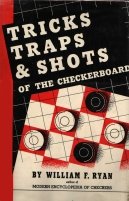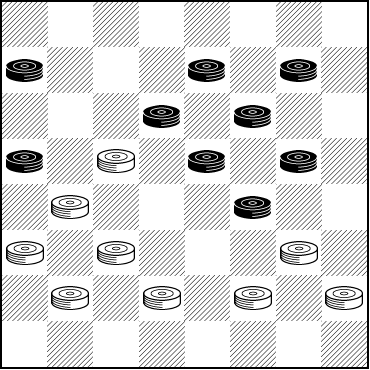The Checker Maven
Jump to navigationScott's Close Shave

Cutting your lawn very short, perhaps too short for the good of the lawn, is often referred to by a term which is now considered politically incorrect and offensive to some. The word in question supposedly shouldn't be used any longer.
But an alert reader pointed out that, in our republication of Willie Ryan's Tricks Traps & Shots of the Checkerboard, we omitted an entry called Scott's Sc*lp*r. We're remedying that omission with today's column and have renamed it Scott's Close Shave, which we hope will make the LTBO ("Looking To Be Offended") crowd happy.
Let's let Willie give an introduction in his own words.

"The feature performers in this draughts drama were Robert Jackson and A. B. Scott, two of England's foremost players at the turn of the century. Sir Scott, who handled the white pieces, was a sagacious specialist in the management of weak, off-color, or radical moves, which in most cases he had carefully analyzed and prepared in advance. It is evident from Champion Scott's fine play in the game below, that he was thoroughly familiar with all aspects of the formation into which he lured his opponent, enabling him to spring the hair-raising finale at the diagrammed stage."
Willie's analysis of this game is uncharacteristically flawed. The KingsRow computer engine uncovered some very interesting play. Here's the complete run-up, with notes.
| 1. | 11-16 | 24-20 |
| 2. | 16-19 | 23-16 |
| 3. | 12-19 | 22-18 |
| 4. | 8-11 | 27-23 |
| 5. | 11-16 | 20-11 |
| 6. | 7-16 | 25-22 |
| 7. | 4-8 | 29-25 |
| 8. | 8-11 | 31-27---A |
| 9. | 10-15 | 21-17---1 |
| 10. | 9-13 | 27-24 |
| 11. | 5-9---2 | 25-21 |
| 12. | 1-5 | 32-27 |
| 13. | 2-7---B,3 | 30-25 |
| 14. | 3-8 | 18-14* |
| 15. | 9-18 | 23-14 |
| 16. | 6-10---4 | Forms diagram. |

WHITE
White to Play and Win
W:W14,17,21,22,24,25,26,27,28:B5,7,8,10,11,13,15,16,19
Lettered notes are by Willie Ryan. Numbered notes are by your editor.
A---A powerful attacking move developed by Robertson, Martins, and Wyllie.
B---With this move, Jackson passed up his last chance to draw, but who would ever believe that his choice was to be invalidated in the manner shown? The correct continuation at B is: 6-10, 17-14, 10-17, 21-14, 13-17---5, 22-6, 15-31, 24-8, 31-24, 28-12, 2-27, yielding a draw. John Robertson.
1---Willie didn't note this, but the move appears to lose according to KingsRow.
2---2-7 would have kept a stronger advantage but Black may still have a win.
3---Turns a probable win into a possible loss. Willie's analysis isn't quite correct. See note B above.
4---A mistake that loses at once. 6-9 would have given Black better chances although he's still in a possible loss.
5---This move is hard to understand and throws away the win. 3-7 is correct here. Perhaps the spectacular exchanges diverted Willie's attention.
Do you see the White win from the diagrammed position? Work it out and then click on Read More to check your the solution.![]()
Solution
Continue: 22-18*---C, 13-29, 21-17, 15-31, 24-6, 31-24, 28-3, and White Wins.
C---Black (then) has the option of jumping four different ways, and they all lose! Truly a fine conception.
We certainly don't mean to be critical of Mr. Ryan, who was a great player, analyst, and writer. But today's world-class checker playing programs find things that no one ever would have expected, and it's just further proof that the game of checkers is far from exhausted, with many hidden treasures still awaiting discovery. And, we believe, none of them are politically incorrect or offensive[1].

[1]---Dangerous last words. The LTBO crowd is nothing if not creative.
You can email the Webmaster with comments on this article.
